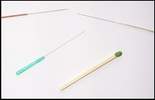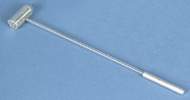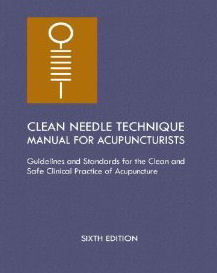Acupuncture Resources
Conditions Treated | Needles | Moxibustion | Cupping | Auriculotherapy | Acupressure | Gua Sha
Treatment with Acupunctre Needles

The filiform needles are widely used at present in clinic. These are the needles that we most frequently associate with acupuncture. Thaey are made of gold, silver, alloy, etc., but most of them are made of stainless steel. A filiform needle may be divided into five parts :
- Handle the part webbed with filigree either of copper or stainless steel
- Tail the part at the end of the handle
- Tip the sharp point of the needle
- Body the part between the handle and the tip
- Root the demarcation line between the body and the handle
- The length and gauge refer to the dimension of the needle body.
The common filiform needles vary in length and diameter.
Needles from Nos. 26 - 32 in diameter and 1 - 3 cun in length are most frequently used in clinic. The needle tip, in general, should be as sharp as a pine needle, the body is round and smooth, flexible and resilient, which is valued as the best quality. The filiform needles should be well stored to avoid damage. On manipulation, insertion of the needle should be neither too forceful nor too fast to prevent it from getting bent. If the needle tip touches the bones, the needle should be withdrawn a little to avoid bending.
Length cun mm
0.5 15
1.0 25
1.5 40
2.0 50
2.5 65
3.0 75
3.5 90
4.0 100
4.5 115
5.0 125
Gauge No Dia. ( mm )
26 0.45
28 0.38
30 0.32
32 0.26
34 0.22

THE CUTANEOUS NEEDLE
The cutaneous needle is also known as the plum - blossom needle and seven - star needle, which is made of five to seven stainless steel needles inlaid onto the end of a handle. It is used to prick the skin superficially by tapping to promote the smooth flow of qi in the meridians and regulate the functions of the zang - fu organs.
The seven - star needle. Composed of seven short stainless steel needles attached vertically to a handle five to six inches long. The plum - blosom needle. Composed of five stainless steel needles in a bundle and attached to a handle perpendicularly one foot long. The tip of the needles should not be too sharp, but on the same level with equal space between them, otherwise, pain or bleeding may happen during tapping.
Indications
This superficial tapping is particularly suitable to treat disorders of the nervous system and skin disease. It is used for headache, dizziness and vertigo, insomnia, gastrointestinal disease, gynecological disease, skin disease, painful joints and paralysis.
Manipulation
After routine and local sterilization, hold the handle of the needle and tap vertically on the skin surface with a flexible movement of the wrist. The tapping may be light or heavy. Tap slightly until the skin becomes congested, or tap heavily until slight bleeding appears. The area to be tapped may be along the course of the meridians, or on the points selected, or on the affected area, or along the both sides of the spinal column.
The tips of the needles should be even and free from any hooks. On tapping, the tips of the needles should strike the skin at a right angle to the surface to reduce pain. Sterilize the needles and the local area to be treated. After heavy tapping, the local skin surface should be cleaned and sterilized to prevent infection. Tapping is not allowed to apply to the local trauma and ulcers.
THE INTRADERMAL NEEDLE THERAPY
The intradermal needle is a kind of short needle made of stainless steel wire, especially used for embedding in the skin. There are two types : the thumbtack type and grain - like type. The intradermal needle is also known as " embedding needle, " developed from the ancient method of needle retaining. It can exert the continuous stimulation produced by the implanted needle.
The thumbtack - type needle, which is about 0.3 cm long with a head like a thumbtack
The grain - like needle ; about 1 cm long with a head like a grain of wheat. It is mostly used in clinic to treat some chronic or painful diseases which need long time retaining of the needle, such as headache, stomachache, asthma, insomnia, enuresis, abnormal menstruation, dysmenorrhea, etc.
Manipulation
The grain - like needle is applied to points or tender spots on various parts of the body while the thumbtack - type needle is generally applied to the ear region. Embed the sterilized needle into the point, leaving its handle lying flat on the skin surface, and fixing it with a piece of adhesive tape.
Precautions
The duration of implantation depends on the pathological conditions in different seasons. In summer, the needles are generally retained for one to two days because of excessive sweating which is likely to cause infection. In autumn or winter, the retaining duration may be longer according to the need in specific cases. Try to avoid embedding the intradermal needle at the joints to prevent pain on motion. In the purulent infected area or skin ulcers it is not allowed to embed the needle
During the embedding period, keep the area around the needle clean to prevent infection
THE THREE - EDGED NEEDLE
The three - edged needle is developed from the sharp needle of the Nine Needles created in the ancient times. The needle is shaped in a round handle, a triangular head and a sharp tip.Indications. The three - edged needle functions to promote the smooth flow of qi and blood in meridians, dispel blood stasis and eliminate the heat. It is advisable to treat blockage of the meridians, blood stasis, excess syndrome and heat syndrome, such as high fever, loss of consciousness, sore throat, local congestion or swelling.
Manipulations. There are three kinds of manipulations.
- Spot pricking. This is a method known as collateral pricking in ancient times used to treat disease by pricking the small vessels with a three - edged needle to obtain a little bloodletting. During the operation hold the handle of the three - edged needle with the right hand, prick swiftly about 0.05 - 0.1 cun deep at the area for bloodletting and withdraw the needle immediately. After pricking, press the punctured hole with a dry cotton ball until the bleeding stops. This is the most widely used method in clinics, for example, pricking B40 to treat lumbago due to stagnation of blood, pricking L11 to treat sore throat, pricking P3 and B40 to treat acute vomiting, pricking Taiyang ( Extra ) or apex of the ear to treat acute conjunctivitis
- Clumpy pricking. Prick around a small area or a reddened swelling, then press the skin to make the decayed blood escape. This method is mostly used for carbuncles, erysipelas, etc.
- Pricking. During the operation, pinch up the local skin with the left hand, prick the skin 0.5 cun deep with a three - edged needle to make bleed. If there is no bleeding, press the punctured part until bleeding occurs. This method is mostly used to treat multiple folliculitis. For multiple carbuncles of the neck, try to find the red spots at the both sides of the vertebra, and then prick them with a three - edged needle till bleeding
Precautions
Aseptic operation is applied to prevent infection. For spot pricking, the operation should be slight, superficial, and rapid. Bleeding should not be excessive. Avoid injuring the deep large arteries. Pricking shall in no case be applied for those with weak constitution, for pregnant women and those susceptible to bleeding
 Clean Needle Technique Manual for Acupuncturists:
Clean Needle Technique Manual for Acupuncturists:
Guidelines and Standards for the Clean and Safe Clinical Practice of Acupuncture, 6th Edition
Clean Needle Technique Manual for Acupuncturists: Guidelines and Standards for the Clean and Safe Practice of Acupuncture, 6TH Edition, represents an extensive update and reorganization of information, including new chapters on Exposure Control Plans, Practitioner Health and Hygiene, and Record Keeping. Also new, is expanded information on blood-borne pathogens and establishing and maintaining a clean and safe office environment.
The format of the Manual has been updated for clear and concise presentation to aid accessing information quickly and includes additional space for notes and commentary. The 6th edition of the Clean Needle Technique Manual for Acupuncturists reflects the efforts of educators and professionals in the acupuncture and Oriental medicine field to bring you the most up-to-date information available, including OSHA and CDC standards and is the definitive guide to the safe, clinical practice of acupuncture.
It is the manual required by the Council of Colleges of Acupuncture and Oriental Medicine to be used in preparation for the Clean Needle Technique Exam. This exam is required for national certification, which in turn, is required by most states for licensure as an acupuncture and Oriental medicine professional. For 25 years, the National Commission for the Certification of Acupuncturists, Council of Colleges of Acupuncture and Oriental Medicine, National Acupuncture Foundation, and colleagues across the United States, have collaborated on the establishment and revision of the standards for the clean and safe practice of acupuncture.
The Clean Needle Technique Manual for Acupuncturists, 6th Edition, is the product of that ongoing collaboration. The Clean Needle Technique Manual for Acupuncturists: Guidelines and Standards for the Clean and Safe Practice of Acupuncture, 6TH Edition, is available in English, Chinese and Korean